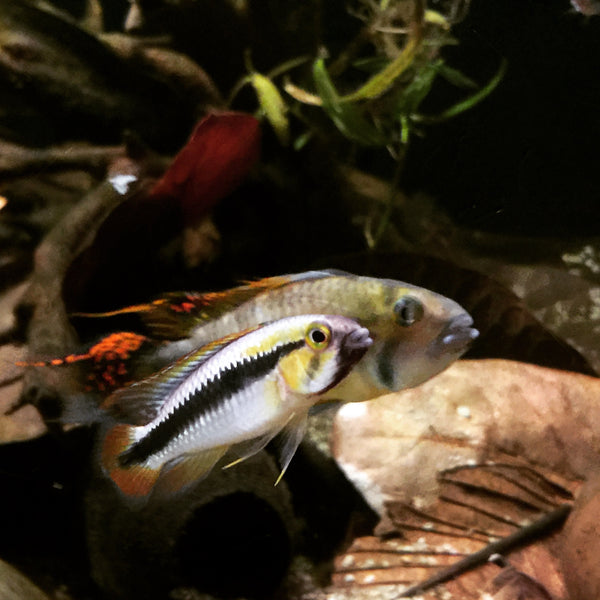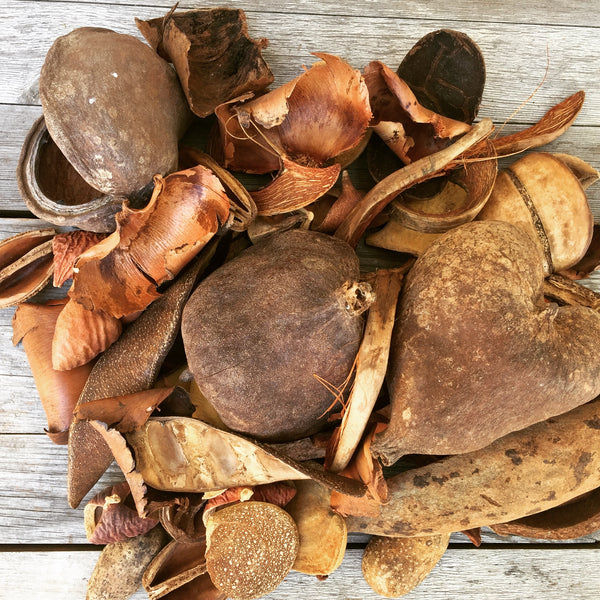- Continue Shopping
- Your Cart is Empty
Skills you have...and need.
Okay, you know I’m forever harping on you about getting the soul back into aquarium keeping, abhorring things like Facebook auctions and relegating expensive controllers to turning on and off the lights (nothing like an $800 light timer, huh?). I’ve prodded you to put down your test kits and stare at your tank more. Hey, I’m a bit cranky, but I admit it. You know a lot of my cranky knocks on some of the latest “trends” is because I think we’ve gotten away a bit from some of the basic skills that we need to be great aquarists.
A lifetime in both fresh and saltwater has taught me a few things…
So, today, I’ll put my money where my mouth is and launch into a bit on just that: Skills that I think we all need to work on to be better fish geeks. I’ll start you off with my ungainly “two cents worth”, and you fill in the large swaths of missing stuff, ok? Deal.
A keen sense of smell. REALLY? You’re starting the list off telling me I need to SMELL better? Well, yeah…Think about it. As a reef person, I have a pretty good sense of it, if I say so myself! There is nothing quite like the smell of “SPS coral death”, is there? Once we’ve smelled that, we will forever be attuned to it. I can walk in a fish room, store, or my facility and tell by smell if something is wrong…Now, cut the jokes…seriously! As a reefer, you simply have this stuff down: Those of you who frag corals will understand and know what I mean about the” dead coral tissue” smell. You’ll also become keenly attuned to the smell of a protein skimmer that needs your attention...
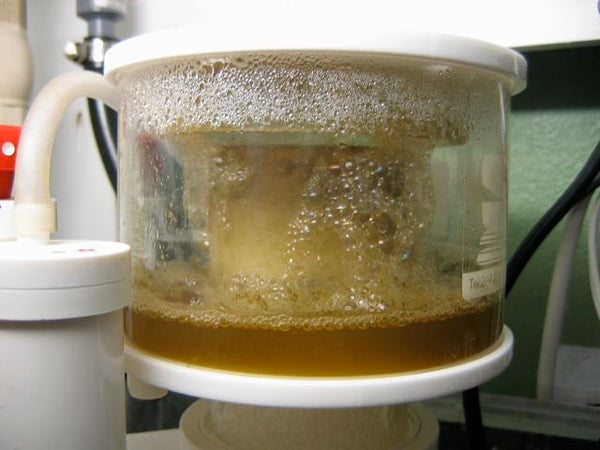
I can’t use words on this family friendly site to adequately describe that one! You’ll also know the way a freshwater tank should smell when things are going well- earthy, “garden- like”, and pleasant. Bonus- you’ll learn to recognize the smell of fish food to the point where you’ll remember if you left it out of the fridge all day and rushed off to work! Bonus- if you use ozone, you’ll easily be able to discern the smell of excessive ozone, much in the way you can smell a gas leak. So yeah, a sense of smell is high underrated in aquarium keeping, but pretty important!

Plumbing knowledge. Yeah, that’s kind of a given if you're a fish geek. You need to know the difference between a “Street L” and a 90 degree slip FIPT fitting, or a ball valve and a gate valve. When you’re just starting out in the hobby with no plumbing experience, it’s a bit daunting. However, after building your first tank and several months in the hobby, you’ll be haunting the plumbing aisle at your local home improvement like an old pro…And you’ll be seriously stoked when you can apply your new found plumbing skills to something more practical, like a leaky faucet! You’ll be like, “That’s NOTHING to fix compared to setting up my fish room! Piece of Cake! I can DO this!”
Household cleaning skills. Huh? Yeah, you need to be really good at stuff like cleaning hardwood floors and carpets after those little “accidents” that seem to always happen. You need to know where every spare towel, cleaning solution, and trash bag is. This is especially true if you have a doubting spouse, family member, or other co-habitant that already thinks you’re nuts because you spent $300 on a box of “Seriyu Stone” Knowing where the cleaning supplies are can totally save your hobby gig in an emergency.

(Especially true when the “Spouse Factor”, as they say, looms large as a potential issue. Added plus for guys- knowing how to operate the washer and dryer- and how to fold the towels to replace them in the closet as if nothing ever happened is a big plus! Better yet, have the number to the local jewelry store saved on your "Favorites" list on your phone…I’m not trying to sound sexist, but if the way to a guy’s heart is through his stomach, there seems to be no better way to a non-aquarium-keeping female’s heart than the jewelry store! It's like- factual...I consider this a “nuclear option”, of course, to be utilized when you REALLY screw something up!

Balance. Yes, you heard me. As reefers, especially those of us with larger aquariums, we spend an inordinate amount of time on step ladders, on our tip toes, and leaning over and under our tanks. It’s an inevitable part of the game. You have to be able to balance on the near top rung of the step ladder, while holding a heavy rock in one hand and a piece of wood in the other, and deftly maneuver both into position. Often, this involves a complex calculation in our head, taking into account things like depth, length, and even the refraction cause by the water’s surface.

This enables us to place things in our tanks with uncanny precision that people engaged in other hobbies can only dream of. If you're into Yoga, you do have an unfair advantage over most fish geeks, as the flexibility you’ll gain will totally save your a** one day when you’re trying to place that big piece of Spiderwood on the ledge in your rock structure while holding a wadded up ball of epoxy in the other…Mad skills.

Negotiation skills. Yeah, you need to be able to convince the guy on the other end of the counter or phone, be it at a livestock vendor, LFS, or online dry goods vendor, that you MUST have that item delivered by tomorrow, even if the odds are against him or her having it in stock for another week. Who cares if there is a waiting list that’s been in place for weeks. YOU need to be on the top of the list, because YOU must have that new light in your hands before anyone else. Getting favors out of the LFS people is a huge skill that cannot be overlooked, either. This is often a skill one develops over time by spotting weaknesses in the employees. For example, if you know that the manager has a weak spot for say, donuts, you can’t tell me that she won’t give you the extra consideration when you walk in with a box of ‘em for the staff “just because” one afternoon, and then ask innocently if it would EVER be possible for them to net a few fry of that crazy Apisto in the display tank..you know, then one that says “not for sale!” on the tank? Seriously, this technique works..Learn it.

Weight training. Yeah, that’s actually kind of a no brainer. We are constantly lifting heavy and awkward stuff as reefers, aren’t we? I mean, a 5 gallon bucket of water is frickin’ heavy when you’re balancing on a step stool! And moving around big pieces of rock or buckets of water during changes is no easy feet. You need to have some strength as an aquarist…Of course, you can combine this strength with some of the other skills mentioned above to help leverage help when you need it! Like, knowing strong fellow hobbyists is always a huge plus when it comes time to moving that new 300 gallon tank into your living room. Cultivate fish geek friends who play rugby or American football Other skills, such as bing a good cook, a massage therapist, and having amazing plants that people want cuttings of will definitely help you compensate if your upper body strength isn’t quite there yet. You’d be surprised how far “properly-motivated” (and strong) fish geeks will drive to help you lift a heavy tank. Uncanny.

(This one again is for my saltwater friends…specifically those who keep coral.) Ability to remove glue from fingers. Don’t overlook this skill! If you operate in just about any other business sector besides the coral trade (where it’s pretty much expected that you’ll have dried super glue on your fingers on a regular basis), you need to learn how to get the stuff off of you- and quickly! It’s not too professional for most people to have dried glue all over their fingers. Yet, as reefers, we kind of wear it as a badge of courage, a sign of respect, much as a military person has rank insignia. A reefer at the local frag swap with dried glue all over his or her hands is recognized as a VERY serious reefer…They’ve paid a heavy price in both skin and glue. Nonetheless, it’s equally as important to learn how to use the proper solvents to get this crap off after you’re done fragging up that massive efflo! Especially if you’re on the singles scene, dried glue is not cool. Knowing when and how to remove glue are overlooked and highly necessary skills!

Okay, I’ve started you off with seven vital skills and attributes that you must have as a fish geek. I have overlooked literally dozens in this abbreviated list. The aquarium world is counting on you to share the secrets you know…Please don’t let us down. Let’s see your contributions to the leaky “tank of knowledge” that is “aquarium culture!”
Have a great day, a great Holiday, have some fun, support your LFS (and favorite online botanical vendor, of course!)…but most of all…
Stay Wet.
Scott Fellman
Tannin Aquatics
3 Lessons for success...Taught to me by..YOU.
As someone who's spent a lifetime in the hobby, I'm shockingly less stubborn than you'd expect. In fact, I'm open-minded to the point where I actually listen to my fellow fish geeks, gleaning little pearls of wisdom along the way.
Here are 3 of the best lessons learned from the best people I know- my fellow fish geeks!
Stay "true" to the species. Don't force fit them to "adapt" to conditions that are easier for you to maintain, less expensive to provide, or quicker to create. Fish kind of have a way of "knowing" if you're not giving them exactly what they want. It's called NOT SPAWNING. In almost every instance, spawning a fish requires you to provide the exact conditions that the FISH need, NOT the ones that are your personal faves. I'd love to keep and spawn Mbuna in a blackwater aquarium, really- but that ain't gonna happen. Nope.
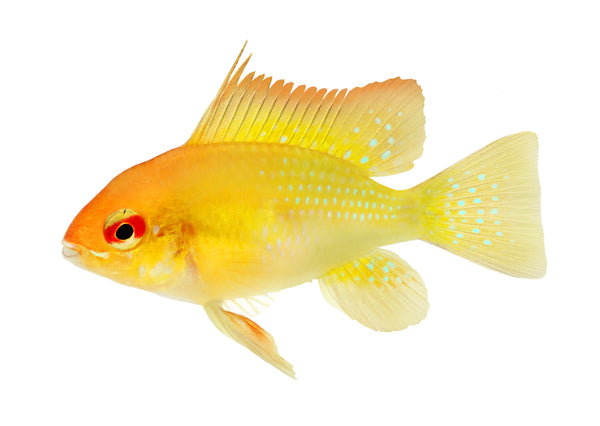
Specialize in at least one hobby "niche." Or at least, learn all you can about a few specialized areas. Yeah, really get deep into some stuff, wether it's about plants, breeding Spiny Eels, culturing live foods, or building glass aquariums- just crush it! Become an expert of sorts. Why, you ask? Because it's important in the grand scheme of the hobby to have lots and lots of hobbyists who know all about a few things. This helps countless others solve their problems. And let it be known. Share your expertise on social media, club forums, etc. As a "resource", other hobbyists will know that they can turn to you for the definitive answers on how to culture microworms! Yeah. Sweet.

(Extra credit)- Specializing in a species or type of fish is good for you- because you develop an expertise in the fish...and great for the hobby in general, and wild populations of the species you work with....always a good thing, right?)

Build a "team" of hobbyists you can refer to for assistance. Yeah, make friends. Tough for some of you curmudgeonly types, but it's actually easy in today's "I-can-hide-behind-my-iPad-screen-on-the-couch-in-my-underwear-while being social" society. Having other hobbyists who have experience in an area you're into is not only a cool social experience, it helps "widen the reach" of knowledge within the hobby. I mean, if you get help from "Jan in Oslo" about the blackwater tank you're building, then when "Rick in Denver" needs some help, YOU will be in a position to pass it on... Go team!

Patience. Always patience.
We'll see you tomorrow!
Until next time...
Stay inspired by others. Stay true to yourself. Stay patient...
And Stay Wet.
Scott Fellman
Tannin Aquatics
Only a fish geek knows...
Despite all of the bickering about what approach is best, what the coolest fishes to keep are, and who makes the best water pump, as fish geeks, we can all agree about one thing: The aquarium hobby offers you a dazzling array of incredible experiences, many of which those who aren't attend to our geeky obsession just don't understand.
Yet, we DO.
After a lifetime in the hobby, I've arrived at a few of the things that make me feel best in the fish-geek universe. Here are just a few:
Hatching killifish eggs. Isn't there something just amazingly delicious about packing your fish eggs in peat fibers in a ziplock bag for 2, 3, 6 or even 9 months, storing them in a drawer some place, in anticipation of "hatch day?" Pouring some water on them, and...waiting. Yeah, and when the first fry actually appear, sometimes only after a second, or even third "inundation"- you tell yourself how cool this all is; how worth the wait it was, get lost in the wonder..and then we reach for the brine shrimp eggs, of course!

"First water". Yeah, I don't care if you've set up one aquarium, or 4,000 of 'em in your "hobby career", there is something just amazing about adding water to a tank for the first time. There is a sound, a "new tank smell", a feeling of anticipation...all of that potential, ready to be unlocked. Is this the aquarium in which you'll spawn those Pencilfish that have been eluding you for so long? Will this be the one that you use to grow out and breed the cichlid pair that your friend collected in The Congo? Is this the tank in which you're going to create the award-winning aquascape? The excitement is palpable, the anticipation is great, and the experience...well, only a fish geek understands, right?
Adding new fish to your collection. If you're a real fish geek, you just cannot take the addition of new fishes to your collection for granted. We study, prepare, each, and even lust after that one fish, so when it finally becomes available, you're more than ready to strike. We all have that ONE fish...you know the one. Something about the whole process- research, sourcing, preparing- that appeals to some instinctive "hunter/gatherer" thing we have in our DNA. And after careful acclimation and quarantine (hey, a guy can dream, right?), when you add it to your aquarium and see it swimming there for the first time- it's undeniably special. The end of a long pursuit. The beginning of a new experience!

Sharing your work. Let's face it, everyone likes to show off a little, and we're not an exception. And, in 99.999% of the cases, with fish geeks, it's not about "bragging." It's about the satisfaction of sharing something you love with others. So, wether it's that new Amazon-themed aquascape your "debuting" to the club, or the Betta channoides fry that you've painstakingly reared, or even that beautiful custom stand that you've built, sharing is one of the best parts of our hobby. You inspire, teach, learn- and gain friends i the process. What could be better?

Helping out a hobbyist in need. Yeah, there is something incredibly unique about the way we as fish geeks help each other out in the hobby. We've all been there before: Something goes wrong; your favorite fish contract a disease, your aquarium springs a leak, you have a major equipment failure. And you turn to your fish-geek friends...who ALWAYS come through. Wether it's answering a question, helping collect gear and fish for a hobbyist who's fallen on bad times, or physically helping with your tank, this is an amazing thing. I know many, many fish geeks who will, with almost no reflection, happily drive 45 minutes...on a Tuesday night...in bad weather...to help a fellow fish geek out in an emergency. Even one they just met. This is one of the most incredible parts of our hobby community. The way we care for members of our "tribe" when they need it. A testimony to the awesome bond that is created by sharing a mutual love for all things "aquarium."

There are countless other amazing feelings and experiences that only those of us who play with water understand. These are just a few of my faves; you no doubt have your own. And isn't it nice to look back and reflect on some cold winter night in front of your aquarium- to realize that the journey you've taken as a fish geek has given you so many incredible experiences? And isn't it even better to help others in the hobby accumulate and enjoy their experiences? It sure is.
It feels great. And yes, only a fish geek really knows the feeling.
So, help spread it.
Stay humble. Stay devoted to the craft. Stay generous. Stay inspiring.
And Stay Wet.
Scott Fellman
Tannin Aquatics
Beyond the "Betta Bowl" fantasy...
If you're like many fish geeks, at one time or another, you've probably kept at least one Betta at some point in your "career." Most likely, a "fancy" variety, purchased in a little cup, and then unceremoniously added to a little bowl somewhere.
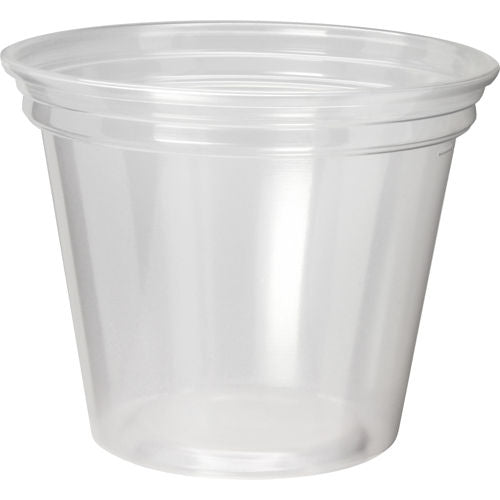
Until relatively recently, this was my impression of Bettas in the aquarium hobby. One species (B. splendens), small bowls and cups, and improperly kept, dangerously inbred, low-quality fish found by the million at "big box" pet stores. And of course, for the longest time, I believed that these fish favored the confining, decidedly not-so-good environment of a small container of water.
And, how could you fault me? That's kinda how they've been "sold" to the world for generations...
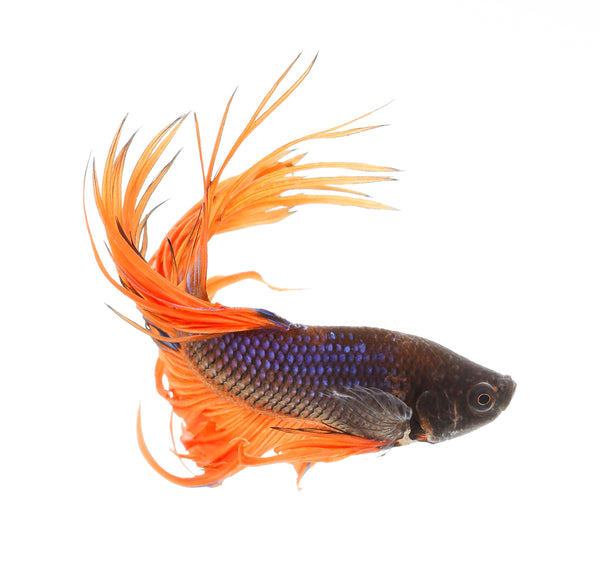
Sadly, the cultural myth of Bettas being adapted to this kind of micro-environment has endured in both the hobby and popular culture, and we're all pretty much convinced that they live exclusively in little tiny puddles in Thailand, Cambodia and other parts of Southeast Asia.

And the sad part is that there is a little hint of truth to this. Sure, they are found in little puddles and evaporating pools of water along roads, ditches, and rice paddies...but it's kind of out of their excellent survival capabilities, clinging to life in evaporating puddles, rather than out of some innate preference for tiny spaces. They have good jumping capabilities for a reason, right? I'd venture to guess that it's to help escape from these little tight spots when the water gets really nasty!

And of course, because they're often seen in their native habitats in these little puddles and such, and are extremely adaptive to survive (not the word- "survive") such tight spaces with lower water quality...and we hail their remarkable ability to tolerate the nasty conditions found in these desiccating tracts of water, because of their "labyrinth organ." And by extension, we can use this to justify the fact that they are kept in smaller bowls and such by hobbyists of all skill levels. It's almost like they're perceived by many of us non-specialists to be just like annual killifish, ecologically adapted to live in evaporating puddles as part of their life cycle, when the reality is that these fish can live for 5 years or more with proper care!
Oh, and there are like 70-plus recognized species in the genus Betta!

Now look, before every world class Betta breeder who's forgotten more about the care of these fish than I'll ever know jumps on me and tells me that I'm drinking some "Tree Hugger Koolaide" or something (someone told me that once, lol), I'll acknowledge that, of course, they can be kept in small containers when given excellent care. Hobbyists have been doing it that way for generations. Yet, what I kind of wonder about is how come we- the non-Betta specialists, are still buying into the 'fairy tale" that this is the best way to keep them because it's the fish's preferred environment...Just because we can keep them this way doesn't mean it's the proper thing for the fish, right?

When you dig a little deeper, as many experienced Betta enthusiasts have, you find out that they generally come from much larger, more permanent, and thickly vegetated habitats. Little pools of water, rice paddies, sluggish streams, and small marshes choked with vegetation, leaves, branches, etc.

Of course, this is where my interest comes in...They are often found in habitats that are just like the ones we play with: Tannin-stained, botanical-packed, and uniquely interesting!
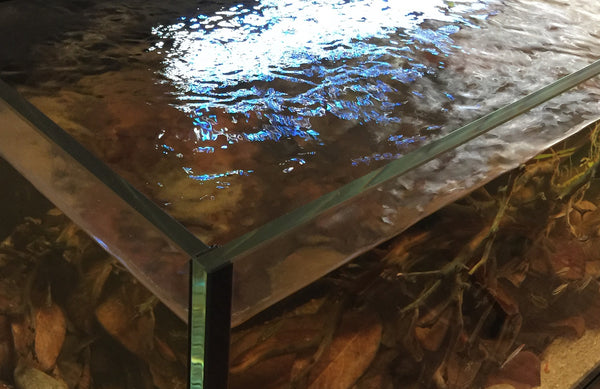
And of course, there are a LOT of different species of these fish, as many of you know, and some have adapted to different types of niches, like under leaves and submerged branches, etc.

And of course, it's kind of hard to replicate this habitat in a tiny cup of water, so why not set up an aquarium just for them?

Something with some small rocks, wood, and a lot of leaves and sturdier botanicals!
And you might want to experiment with a pure "botanical bottom" of mixed leaves and some of the smaller seed pods and such, to really create a more accurate portrayal of the surprisingly diverse habitats from which these fishes come.
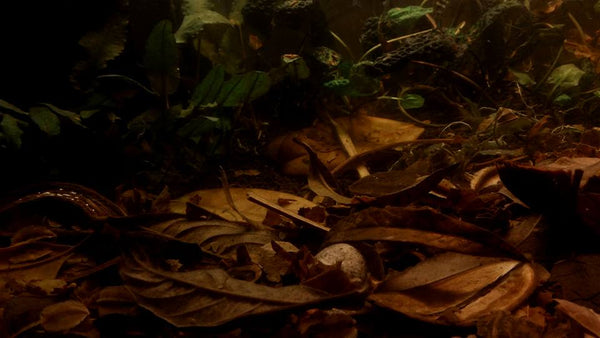
Our friend Mike Bognich has been doing a lot of work with deep leaf litter bottoms, and I suspect these would work well with a variety of wild Betta species.

Kenneth Kinchen has shared with us a number of cool shots of his wild Betta botanical-style aquariums, and these are perfectly suited to these unique fish!

And our buddy Ron Mastero and his son Nate, of Functionbuilt Aquatics have done some incredible paludarium-type tanks just for wild bettas, and his fish room is filled with blackwater/botanical "sexiness!"

The variety of Betta species is so incredible, each with unique color patterns, morphology, and requirements that you might just devote a bunch of tanks to them...a really fascinating hobby within a hobby!

Hopefully, this embarrassingly generalized, incredibly short visit to the "alt Betta" world may have provided you with some incentive to look more closely at these captivating fishes, and to keep them in far more natural, interesting conditions than you may have previously even considered.

Hopefully, the "Betta Bowl" of the 21st century will be a properly-outfitted small aquarium with filtration, heat, botanicals, blackwater, and plants, a far cry from the popular, yet shockingly one-dimensional way we've kept these fishes for so many years.
Learning new things about fishes that you may have taken for granted is not only humbling, it's fascinating, enjoyable, and makes you realize just how awesome the aquarium hobby really is!
Keep exploring.
Stay fascinated. Stay curious. Stay creative. Stay skeptical.
And Stay Wet.
Scott Fellman
Tannin Aquatics
Don't sweat it.
As an experienced aquarist, you've no doubt had all of those "unexpected", unfortunate, or otherwise unwelcome things happen in your tanks, right?
You know, stuff like algae on the rocks or wood, or substrate that gradually develops a "patina" of algae on it.
You know, stuff that just "happens" in aquariums over time.
Stuff a lot of hobbyists tend to stress out over. Stuff that freaks some of us out!
I'm here to tell you- don't sweat it. Really.
The biggest "buzzkill" for almost every hobbyist who's ever lived is algae. Far and away, the number one stress-causing, mind-blowing, blood-pressure-raising issue for most hobbyists is the appearance of algae. To us, a little algae means that this weird "chain reaction is gonna happen and pretty soon, your entire tank will be overrun by a carpet of nastiness!

Now, for a lot of hobbyists, even some algae is seen as a sign that your system is "out of balance", with perhaps an excess of nutrients accumulating somewhere in the system. Obviously, this is a superficially correct observation. The occurrence of algae means that there is sufficient nutrient in the aquarium to fuel its growth. Duh.

Yet, what is that always a bad thing? Algae is among the oldest, most adaptable life forms on the planet, and will exploit every available opportunity to flourish. It's consuming some of the nutrient that you don't want accumulating in the first place! It's beneficial in many cases, as it is an efficient processor of organics, produces oxygen, serve as food for many aquatic creatures and provides a "substrate" for small crustaceans and other life forms which our fishes consume as part of their diet. When you think about it, the appearance of algae in the aquarium is actually an indicator that thing are functioning pretty well!
There's a lot to like about algae, if you really think about it.
Sure, the "dark side" to algae is that it can smother your plants and cover everything if left unchecked. Now, that IS the sign of an unbalanced aquarium, when it's growing faster than your plants, or literally taking over every surface. Yet, some growth of algae on rocks and wood is not only not cause for alarm, it's really a natural and almost inevitable thing.

Yet, we have been trained over the century or so that we've been keeping aquariums to loathe the appearance of algae; to fear it and take drastic action when we see it. The bulk of the algae "problem", IMHO, is in our minds. It's that it's been perceived as an affront to our aesthetics in the "popular" hobby, because we've been told that an aquarium should appear near "sterile", or at least, devoid of any growth that we think is "unattractive." And I think that's kind of sad.
Of course, aquarist who keep Mbuna will tell you algae and overgrowth of associated microorganisms, or "aufwuchs"- is simply part of the game, as it's a natural and necessary part of these fishes' environment. It's not seen as "ugly"- it's seen as necessary. And its appearance in the aquarium is considered a sign of success!

Marine aquarists as well celebrate the appearance of coralline and other algae as a sign that their system is operating naturally and efficiently. You should, too!
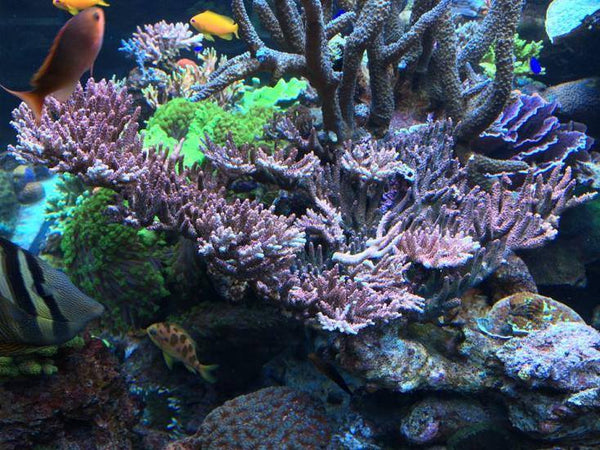
The reality is, algae growth is important. It's seen everywhere on the planet, and it's all over rocks, wood, and other submerged objects in natural watercourses. It's part of the rich fabric of life. Accepting that some algae is not only acceptable, but actually aesthetically interesting will take a "mental shift"- along the lines of the one that we make when we embrace a botanical/blackwater aquarium and its accompanying tinted water, decomposing botanicals, and biofilms.
It's actually not only "part of the aesthetic" of underwater habitats, it's part of the necessary ecological framework.

And that makes it a beautiful thing.
So, next time you notice a little algae film here and there in your tank, don't run off in a panic and reach for the algicide. Look at it and ask yourself if it's really "taking over" the tank,smothering your plants- or just exploiting a niche that's available to it. Ask yourself if it's becoming a burden or danger to the fishes, or simply a "distraction" that you've been accustomed to fearing and reviling throughout your aquarium "career."

Sure, if it's growing unchecked, you'll want to bring it under control. But if it's simply growing in different places in the aquarium, consider this a natural, normal part of an underwater ecosystem. Take a look at some natural underwater habitats and consider its role there. And appreciate the natural, unique aesthetic that it brings.
Is it really so bad?
No, it really isn't.
Don't sweat it.
So says the guy who loves brown water, decomposing leaves, and biofilms in his tanks.

Well, just think about it, okay?
Stay calm. Stay open-minded. Stay curious.
And Stay Wet.
Scott Fellman
Tannin Aquatics
Windows of opportunity to seek out the "champagne problems" in our aquariums
You've undoubtedly thought about this before, right?
When you keep fishes and play with aquariums for a while, you start to notice little "patterns" in your tank. Not only patterns of activity of the fishes, growth in the plants- stuff like that. Rather, you start noticing times when the tank looks better, acts better...functions more smoothly. These are not alway predictable, but they're the times when we proudly report to our fellow fish geeks, "My tank is just kicking ass right now!"

Not only are these times enjoyable to behold, they represent something else: Windows of opportunity to really study and learn what is going on in the aquarium at the moment that has created this wonderful situation. All too often, we follow through on our regular aquarium practices, maybe make a tweak or two hear and there, and possibly- maybe, not an incremental favorable change or two in the tank along the way. However, it never ceases to surprise me how the "moments of awesomeness" that we treasure so much just kind of sneak up on us, right? Wouldn't it be nice to know what causes them?
One of the best times to notice positive changes in our tanks seems to almost always be right after a water exchange. You must have noticed this a thousand times in your tank. Fishes are more lively, colors are better, often times, spawning activities ensue afterwards. What is it about a water exchange? Is it the dilution or removal of waste, the addition of fresh trace elements, humic substances, oxygen? What could it be?

An interesting thing to do would be to take some water tests for multiple parameters in your tank just before and just after a water change. It's a window of opportunity to get a real-time "before and after" view of what's occurring in your tank. And it's not hard to do.

Or, when you just walk into the room where your aquarium is located and just tell yourself, "Wow, it's looking amazing right now!" That would be an optimum time to look very carefully at your tank; to take some notes, do some water tests...find out exactly what the parameters are in the tank. In fact, by keeping a simple regular log (daily would be amazing, but a few times a week is pretty stellar, too!) and reading it from time to time, you might begin to detect some pattern. Like, "X days after a water exchange and feeding of ____, the fishes develop better color and activity levels are up"- stuff like that.

Having an idea of what and when your tank looks its best will give you the opportunity to replicate those conditions more often. At the very least, it will give you valuable clues as to what is happening in your tank when it's performing at its highest level.Then, you can figure out what to do to keep your tank looking and functioning at this level as often as possible.
It can be challenging, elusive, but stuff like this represents the "champagne problems"- trying to figure our what causes the good "issues" to have with our aquariums. Beats solving disease outbreaks or algae issues or..well, you get what I mean.

And it all starts by taking advantage of the windows of opportunity that are provided when your tank is "kicking ass."
Just something to think about on a Saturday. Enjoy your weekend, and the Holiday Season that is upon us!
Stay inquisitive. Stay engaged. Stay on top of things.
And Stay Wet.
Scott Fellman
Tannin Aquatics
Let's hear it for the little guys!
As you can probably guess, I'm an unabashed fan of the little guys...Tetras. And characins in general. Today, as I was looking at my "common" little Tetras in the office aquarium, I just couldn't help but think about how these little beauties seem to be taken for granted at times. I figured I'd pen a quick little piece singing their praises!
Now I know, nerd...I hear you: "Not all characins are little fish!" Yeah, okay, don't hate. But for now, let's concentrate on the little guys for this piece, okay?
I like these little fish for so many reasons, not the least of which being that, for the most part...they're little fish. And typically, peaceful (Yeah, I know Serpaes and Exodon and Piranha and such...but you get the idea). Small, peaceful, inexpensive, readily available, and often colorful is a great recipe for an...underappreciated, taken-for-granted fish!
Yup.
I guess they aren't as sexy as those pricy cichlids. And they're typically tiny, often seemingly devoid of individual "personality", with many being shoaling fish, so in the eyes of some, that probably knocks 'em down a few pegs on the cool scale, as well.
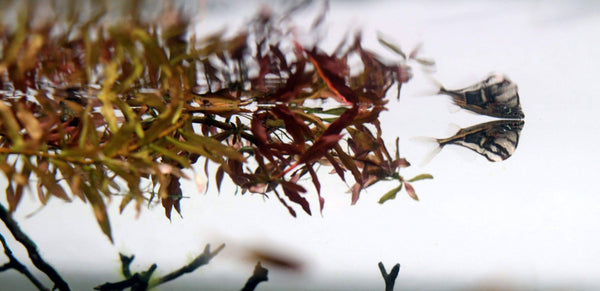
However, I submit that they are among the coolest, best-suited fishes for blackwater, botanical-influenced aquariums. And I feel this way not just because many of them hail from blackwater habitats, but because the very attributes for which we take them for granted- namely, being small, comparatively docile, and colorful- make them perfect for our aquariums! Think about it. Little guys like this tend not to dig and move your leaves and other botanicals all around the tank.

They also tend to contrast nicely against the botanical "field" you've created, and look smashing in the tinted water. Even the relatively clear, "greyish" species (you know, the ones that end up in aquariums because they're incidental "bycatch" from some sexy cichlid or Pencilfish?) really pop against the darker, "earthier-toned" backdrop of botanicals.
Being small means that you can create interesting groups. And interesting groups often end up spawning- particularly when provided with environmental and physical conditions which closely replicate the wild environments from which they hail. And they typically don't need large tanks. And if you're fortunate enough to have a large tank, imagine how cool larger groups of these little guys look..and they're the perfect "scale" for all sorts of tanks. You seldom hear the "armchair critics" railing on a fellow hobbyist for "cruelly housing a Glowlight Tetra in an undersized 5-gallon aquarium" or something like that, right?

And with more and more species being identified- or shall we say, misidentified- species new to the hobby are showing up more and more, adding to the diversity of fishes that grace our aquaria. This is a very cool thing, as it creates a little "sub hobby"- sort of "discovering" new species within the mass market imports, lol.

And with new fishes come new ideas...new discoveries on how to care for them...and innovations in breeding and preserving wild populations...It's very cool what these little fishes can do for the hobby as a whole. And seeing the popular little guys like Glowlight Tetras and Neons in a fresh light will keep them in the hobby forever.

And if you sort of take that approach to many of the "common" little Tetras that we take for granted in the hobby, I think you'll develop a newfound appreciation for their adaptability, hardiness, beauty, and unique challenges.

Much more on this to come...got to run and get some of your orders out!
Have a great weekend. Don't take these little guys for granted.
Stay engaged. Stay creative. Stay active.
And Stay Wet.
Scott Fellman
Tannin Aquatics
The practice of "functional diversity" in the aquarium
In the aquarium game, we're able to control a lot of things in the little worlds we create. You know, the temperature, pH, food, water movement, etc. We put a lot of emphasis on creating "appropriate" environments for the animals that we keep. And we do a great job! In my opinion, we intentionally do this and create what I like to say are "95% effective" systems. And although it sounds that way, it's not meant to be an indictment or "diss" in any way. It's sort of an opinion of mine based on a specific observation:

We're missing the intentional deployment of one concept: Diversity. The one thing that we seem to not practice "intentionally" is diversity of the aquarium environment.
In my opinion, one of the most important things that we can do for the long-term health of our fishes is to create some diversity.
Yeah, diversity.
Now, I'm not talking about the "I-have-14-different- Pseudotropheus zebra-morphs" kind of "diversity." We do a pretty good job at that. I'm thinking a little differently here. We're talking about the diversity of the entire microcosm that you've created in your aquarium.
What strikes me most about many of the most successful aquariums I've seen is their refreshing diversity. They feature a complete range of life forms, such as fishes, plants, and even invertebrates. Just like in nature, these systems incorporate life forms that provide beneficial collateral benefits for their inhabitants, such as food, shelter, and nutrient export. Well-stocked community aquariums are beautiful systems that are a visual delight, affording many opportunities to see examples of the endless variety of aquatic life forms.
And they offer what I call "functional diversity."
The "diversity" applies not only to the life forms in the aquarium in this context, it also applies to the materials that we use to appoint the tank- Like botanicals, leaves, wood, even rocks. In my opinion (and some of it is backed by legit research!), it's beneficial to the inhabitants of a botanical-based aquarium to utilize a number of tannin and humic-substance-producing materials in our aquascapes.
This gives you some good "coverage", in terms of the types of substances imparted. As we are learning, humic substances are very important- perhaps even crucial-to fish health. And since no definitive study identifying exactly what specific humic substances are best, and are released by which botanicals is available, the best thing we can do at this point is to deploy as wide a variety of them as possible.
This is in many ways analogous to the natural habitats of our fishes, isn't it?

I mean, so many things influence the aquatic environment, from soils to tree branches, to seed pods, and of course, leaves, that it's only logical, in my mind, to replicate this component of the wild habitats of our fishes, even if we're "shooting blind" here a bit. There is a reason why habitats such as the Rio Negro are so successfully populated by a variety of fishes, and one can't help but draw the most simple conclusion as to why- it's because they offer the most appropriate and consistent parameters for their inhabitants, which have evolved over time to thrive in them.

And by having a wide variety of materials in our aquascapes as the structural, aesthetic, and functional foundations of our aquariums, we're truly creating a more faithful representation of the natural environment. It all starts with diversity.
Diversity. On many levels. It works. We've been doing it, most of the way, for generations. We've been practicing "functional diversity" with reef aquariums for several decades (you know, live rock, live sand, corals, inverts, macroalgae). Now it's time to sort of "up our game" even more, and make a more conscious effort to practice it in all of our aquariums.

Blackwater, botanical-themed aquariums can lead the charge towards "functional diversity" in the freshwater genre, because we're supplying not only the beneficial humic substances which fishes require, but we're helping create a foundation for a food web, with decomposing botanicals, biofilms, fungi, and of course, the animals which feed on them. We don't see this practiced with the same intent in other freshwater "methodologies", with the possible exception of planted aquariums, which, through use of soil additives and fertilizers, create nutritious and "active substrates" for plants.
We can do the same for our fishes. Can you imagine being able to add "pure", pathogen-free cultures of aquatic insects (okay, not mosquitoes and flying "yucky" kinds, lol) and crustaceans to our aquariums from different regions- say, Amazonia or Asia, which help break down the leaves, consume fungi, and supplement the diets of our captive fishes? Conceptually, we can do this right now...the opportunities for experimentation, implementation, and even commercial exploitation are there!

The mid 21st century may very well see the implementation of exotic concepts, like "crustacean reactors", automated wingless fruit fly dispenser systems, or "food-web-specific freshwater refugiums." (Tip- for some inspiration, check out some of the more esoteric reef information from the early 2000's!)

That's some "next level shit", as one of my fishy friends would say.
And it starts with embracing the idea of "functional diversity" in the aquarium environment; thinking about what it means and how it applies to what we do. And guess what, as a "practitioner" of the "Blackwater/New Botanical-style" aquarium, you're already most of the way there. That "mental shift" we've talked so much about here in regards to these types of aquariums has set you up nicely to explore the "bleeding edge" of aquarium practice, hasn't it?
Take a deep breath, pat yourself on the back for just a second, and then roll up your sleeves and think about how to further develop and employ this concept.
Welcome to the frontier. Kind of nice out here, isn't it?
Stay focused. Stay creative. Stay relentless.
And Stay Wet.
Scott Fellman
Tannin Aquatics
De tenebris, lucem ("from darkness, light")

Have you ever felt like some of the stuff you're doing is starting to pay off a bit?
I'm feeling that, and it's kind of cool that it's happening around the holidays. That "feeling" that tells you that you're doing exactly what you should be doing. Everyone needs to feel that at some point in their lives, I think.
When we launched Tannin Aquatics last year, it wasn't just about selling "twigs and nuts" as some of my friends half-jokingly asserted. We considered it an integral part of our mission not only to inspire and educate hobbyists who had never worked with botanicals/blackwater aquariums before to give them a try, but to "gather up the nomadic outliers" who were playing with these types of aquariums, but perhaps had no sense of community or connection to other hobbyists who shared this passion. It was a pretty tight little niche, and quite frankly, perhaps a bit crazy to base an entire business on, in the eyes of some of my industry friends. Believe it or not, I had complete confidence in it, simply because I loved it so much and had no absurd expectations of "changing the world" with it. I just flat-out enjoy it.

As we've discussed before, the idea of using botanical items to create blackwater-type aquariums is not "new", as hobbyists had played with them for many years. Tannin Aquatics certainly did not "invent" the concept. However, the idea of curating and collating the products, information, and offering inspiration from those who had been working with them previously, all in one place- was new. By creating a place to obtain all of this in one place, and to share and inspire others, you- our growing global community of "tinters"- have helped bring the idea of blackwater aquariums literally out from the shadows. With an ever-growing, impressive "body of work" being shared by hobbyists worldwide via social media, these aquariums are rapidly emerging from the "oddity/sideshow" area, and simply becoming an accepted way to manage a freshwater aquarium. With each new aquarium that is built and maintained based on this concept, the growing "state of the art" of blackwater/botanical-style aquariums is further refined.

While the aesthetic is not something everyone enjoys- dark water, decomposing leaves, biofilms; even algae- there is a certain "something" that seems to appeal to a much wider audience than even we anticipated. It seems to resonate. We're seeing hobbyists from all areas of specialization- ranging from Aquascaping, to Dwarf Cichlids, to Bettas, to Killies, and even to less expected areas like...reef hobbyists- expressing interest in, and creating their own blackwater aquariums. The "those tanks look lame and dirty" emails seem to be less frequent now, lol.

Many hobbyists have told us that there is something alluring about these aquariums and the accompanying aesthetic that they find compelling. The "earthy, organic and natural" vibe that we talk about so much here seems to be catchy. Unlike some of the more "sterile", rigidly-styled variations of "natural" aquariums that have been embraced by many for so long, this "style" of aquarium really seems to lend itself to a far more "realistic" presentation in the eyes of many, and provides the freedom of expression that only nature can provide. Seeing the wonderful pics of wild blackwater habitats being shared by our friends has created a powerful and compelling message for many that these aquariums are some of the more accurate depictions of natural aquatic habitats than many had previously realized. Unique. Vibrant. Brimming with life.

(pic by Mike Tuccinardi)
And, by learning more and more about the important roles that tannins and humic substances from botanicals play in fish health, the practical aspects of these types of aquariums are becoming more and more apparent- and accepted- by a wider range of hobbyists. What many breeders knew for so long- that blackwater conditions can lead to healthier fishes and more prolific, viable spawns- is being experienced and shared by other hobbyists, which will have great long-term implications for sustainability of the animals we cherish. Maintaining these types of conditions "full-time"- not just when we want to spawn our fishes, has been a real paradigm shift for many. We really are starting to blur the lines between nature and aquarium, which is really cool.

Perhaps the greatest "dividend" from this "renaissance" of blackwater/botanical-style aquariums is a renewed interest in, and greater understanding about the natural habitats from which many of our favorite fishes come from, and the need to protect and preserve them for future generations to enjoy.

(pic by David Sobry)
And what does the future hold for Tannin Aquatics? Well, quite frankly, we're just getting started. We have many projects that we want to tackle this year, including growing and refining our services and offerings, having a greater media presence, proving more practical information, further supporting fish clubs, conservation, and research, and expanding upon the promise of the "life" part of our slogan, just to name a few. It's a pretty ambitious agenda; however, thanks to your support- we feel that we're up for the task.
From us to you- may the Holiday Season bring you good times, peace, and happiness. And may the blessings of this season follow you throughout the coming year ahead. Thank you for making us a part of your hobby experience. Together, we've helped foster a growing movement that we hope will provide you with creativity, inspiration, and enjoyment for many years to come.
We look forward to continuing our mission of bringing the concept of blackwater aquariums "out of the darkness" and into the light it deserves.
Stay engaged. Stay inspired. Stay true to yourself.
And Stay Wet.
Scott Fellman
Tannin Aquatics
The answers are there...you just have to find 'em...

If you’ve been in the aquarium game long enough, you’ll encounter some sort of problem with your system...It’s not just a possibility- it’s a near certainty! Yeah, that’s right. Even the best hobbyists with the absolute best aquariums will screw something up. It goes with the territory. It happens to beginners, grizzled vets, and even us so-called “pros.”
Stuff happens.
And guess what? You’re gonna make it through this just fine. That is, if you take the time to learn from your mistake. And you’ll learn from your mistake by asking pointed questions.
I had a former coral customer PM me the other day about (of all things….”Just when I thought I was out, they pull me back IN!!!”) his reef aquarium yesterday, and he had one of those “situations” that crops up every so often. His Acropora coral colonies were slowly dying off, losing color at the tips and working down the skeleton towards the base. It was happening to every Acro in the tank; generally started happening over the last few months.

So of course, we went through the usual questions: How are the basic water parameters (alkalinity, calcium, nitrite, nitrate, ammonia, pH, etc.). What kind of lighting do you have, how is it configured, what is the photoperiod? Then we looked into his husbandry habits…ya' know, water changes, quarantine, feeding, dosing- stuff like that. We talked about the possibilities of any disease or pest being introduced lately. Nope. None of these initial probing questions revealed anything that really stood out.
We then talked about the system…design, components, electrical, water pre-treatment, etc.

Everything seemed to check out. Symptoms we’ve seen before, but no “aha!” moment of revelation.
Time to go deeper…
We discussed feeding, additives he used, salt mix, two part dosing additives…anything that was added to the tank which could potentially be creating or exacerbating the problem. Nothing really seemed amiss. He used popular products from highly regarded brands. In the back of my mind, I couldn’t rule out the possibility of something undesirable- like a contaminant, heavy metal, or some otherwise toxic substance- being released, created, or added to the tank unbeknownst to the reefer. A bad ingredient in a batch of salt mix or two-part alkalinity/calcium supplement? Possible. He was dosing some stuff, but did stop recently…a clue? Perhaps. Source water? Nah, he had a properly functioning, well-maintained RO/DI unit with newer membranes...However, nothing really stood out, but we figured that there was a possibility of something there. Besides, without a real analysis of the water, we’d simply be guessing.

Marine hobbyists have at their disposal yet another powerful tool to assist in “reef diagnostics”- the Triton ICP- OES Professional Water Analysis. It’s a 30+ parameter water chemistry analysis that goes deeper than anything we’ve had before. It seemed to me to be a logical step in attempting to crack this mystery. I recommended it. The client was eager to try it. Oh, I know what you’re thinking: “Fellman is being the consulate salesman, preying on the hapless frustrated reefer by recommending an expensive, $49.00 USD water test.” I can hear the groans.
You know what? I can understand the sentiment if: A) I sold the test to begin with (my former company, Unique Corals, does- full disclosure), and B) I were recommending that the guy “add a little of this or that” product to correct the situation (even though we didn’t identify just what the “situation” is…). THAT is kind of the old-school, seat-of-the-pants “recommendation” that used to give vendors a bad name.

What I recommended to this reefer, who had invested five figures in his system, was to spend the money in an attempt to further narrow down a possible cause to his tank-threatening issue. Using all tools at our disposal is important in solving mysteries. Why attempt to find a problem by conjecture or hypothetical conclusions? The Triton test may not provide an answer to the issue that is threatening my customer’s system, but it may provide some clues. With very low limits of detection, it may be possible to find something that is amiss with the water chemistry. Something that is threatening his reef.

We don’t have the test results yet, so I don’t know yet what- if anything-might be amiss with his water. Furthermore, unless there is something glaringly obvious (like excess heavy metals or other trace elements in concentrations that are known to be detrimental to corals) revealed by the test, we may still have more questions than answers.
Frustrating, huh? You expected a happy, “Fellman-saved-the-day” ending here with a neat, “ CSI-type” conclusion? Well, it might happen…but the point of this tale was not to create false hope. Really. The point is to illustrate that, when solving some of the anomalous problems we encounter as fish geeks, we need to leverage every tool at our disposal. The test was just one of the latest tools that can can be used.
Then, we need to go beyond the obvious.
We need to ask ourselves pointed questions about things that may have transpired with our reef to lead to the problem in question. Was someone else caring for the tank for some period of time? Did the housekeeper spill something into the tank? Sabotage? Did your irate ex-girlfriend decide to throw your Bulgari Diagono Chronograph watch into the sump when you weren’t looking? (okay, men can be vindictive, too, ladies…just using a quick male-centric example here…)

The most important thing we can do when problems strike our aquariums is to not panic. Avoid the obvious instinct to run around like the proverbial “chicken with its head cut off” (that’s a gross one by, the way, if you really think about it. Do chickens really do that? City boy wants to know…makes me glad to be vegan…) and make radical, sweeping changes and “adjustments” to our systems or procedures before the actual problem is identified. Jumping to conclusions and making rapid, seat-of-the-pants “corrections” to undefined “problems” in our aquariums probably causes as many problems as it solves.

So my best advice in this type of situation? Stay calm. Don’t jump to quick conclusions and take random “corrective measures” without being very certain about what you’re dealing with. Creating rapid changes- even positive ones- to an already stressed aquatic population is never a good thing.

Like everything else in aquarium keeping, nothing good happens quickly, even in a “Emergency- type” situation. You just can’t expect that in most cases. A problem such as the one my former customer is experiencing arose over a few months, so a two day “fix” is not likely. Rather, we will probably find that the issue was caused over a period of time- continuously…This at least has given me a hypothetical track to run on in an attempt to find an answer. Could I be barking up the wrong tree? Perhaps…but you play the obvious hunch and analyze clues until you exhaust them. And at some point, if we can't figure it out, I'll have to hand this off to a colleague who's more current/better versed on coral issues than I. That's another thing- don't let ego stop you from getting the correct help! Reach out...

The beauty of the internet age is that we have near-instant access to our “tribe” of fellow reefers 24/7/365, many who may have experienced some of the same things that you are…and may be in a position to offer some clues…Even then, be careful. use the information at your disposal to help zero in on your problem, but don’t rush to action just because “____________” in Pennsylvania had the same symptoms in his reef and it turned out the cause was his phosphate removing media, or whatever. Don’t take the easy road. Don't be lazy. Don't accept and act upon the first reasonable-sounding theory you hear. There are few “plug and play” solutions to aquarium problems. Really.

With that in mind, I wish you success in solving the mysteries that will inevitably arise as you move forward in this hobby. Just relax, be smart about the whole thing, and use every resource at your disposal while attempting to diagnose the problem. In the end, the way you approach the problem, and the solution that you eventually come up with, will benefit you and your animals - and maybe, just maybe- fellow aquarists- for many years to come.
Best of luck.
Stay calm. Stay focused.
And stay wet.
Scott Fellman
Tannin Aquatics




